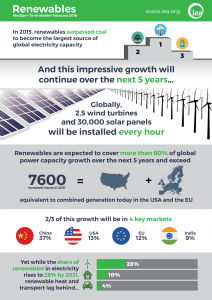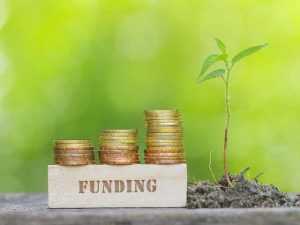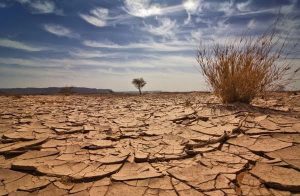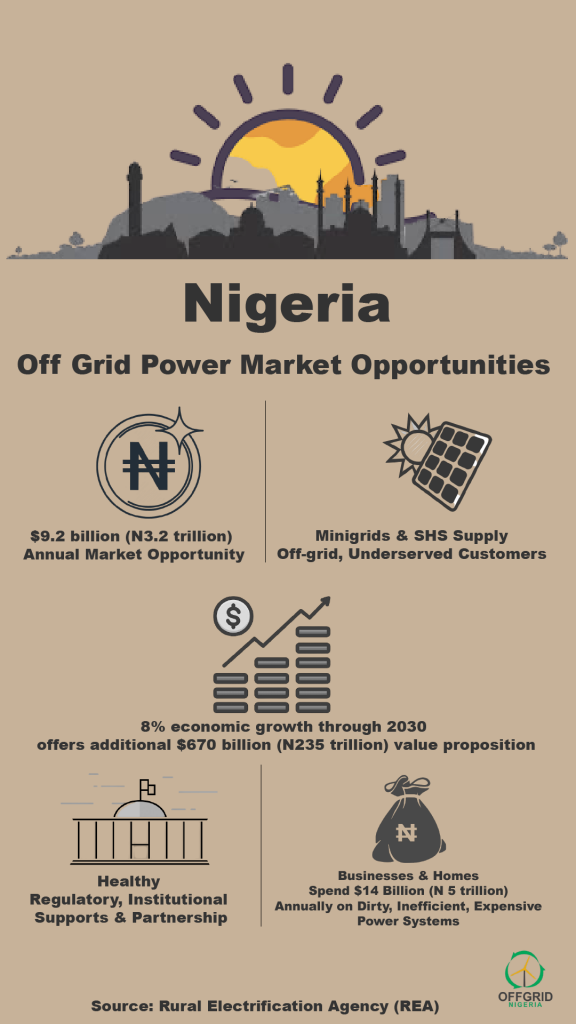Coal outdone by RE in year-end capacity growth
The International Energy Agency (IEA) has said that it was significantly increasing its five-year growth forecast for renewables on the basis of strong policy support in key countries and sharp cost reductions.
According to IEA, renewables in 2015 also surpassed coal to become the largest source of installed power capacity in the world with about 500,000 solar panels installed every day in 2015 to indicate a record-shattering surge in green electricity generation.
The latest edition of the IEA’s Medium-Term Renewable Market Report said it now sees renewables growing 13% more between 2015 and 2021 than it did in its 2015 forecast.
It said stronger policies in the United States, China, India and Mexico are pushing this growth pattern, and that two wind turbines went up every hour in countries like China.
Over the forecast period, IEA explained that costs are expected to drop by a quarter in solar PV and 15% for onshore wind.
It said 2015 marked a turning point for renewables, led by wind and solar to produce more than half the new power capacity around the world and reaching a record 153 Gigawatt (GW) which is 15% more than the previous year.
“Most of these gains were driven by record-level wind additions of 66GW and solar PV additions of 49GW.

“About half a million solar panels were installed every day around the world last year. In China, which accounted for about half the wind additions and 40% of all renewable capacity increases, two wind turbines were installed every hour in 2015,” said IEA.
Its executive director, Dr. Fatih Birol said: “We are witnessing a transformation of global power markets led by renewables and, as is the case with other fields, the centre of gravity for renewable growth is moving to emerging markets.”
IEA also stated that there are many factors behind this remarkable achievement, and listed them to include – more competition, enhanced policy support in key markets, as well as technology improvements.
It said while climate change mitigation is a powerful driver for renewables, it is however not the only one, adding that in many countries, cutting deadly air pollution and diversifying energy supplies to improve energy security were also playing very strong roles in growing low-carbon energy sources, especially in emerging Asia.
The agency noted that over the next five years, renewables will remain the fastest-growing source of electricity generation, with their share growing to 28% in 2021 from 23% in 2015.
“Renewables are expected to cover more than 60% of the increase in world electricity generation over the medium term, rapidly closing the gap with coal.
“Generation from renewables is expected to exceed 7600TWh by 2021 – equivalent to the total electricity generation of the United States and the European Union put together today,” the IEA added.
It however warned that while 2015 was an exceptional year, there are still grounds for caution especially as policy uncertainty persists in too many countries, thus slowing down the pace of investments.
IEA said rapid progress in variable renewables such as wind and solar PV was also worsening system integration issues in a number of markets, while the cost of financing remains a barrier in many developing countries.
The IEA report equally identified a number of policy and market frameworks that would boost renewable capacity growth by almost 30% in the next five years, t perhaps lead to an annual market of around 200GW by 2020.
Birol said in this regard: “I am pleased to see that last year was one of records for renewables and that our projections for growth over the next five years are more optimistic.”
“However, even these higher expectations remain modest compared with the huge untapped potential of renewables. The IEA will be working with governments around the world to maximize the deployment of renewables in coming years,” he added.





